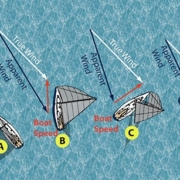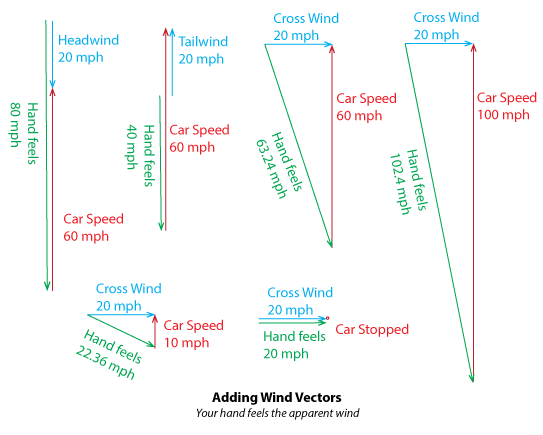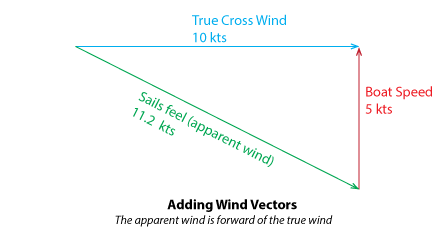Sailing Wind Velocity & Direction
Velocity
A sailboat moves through the water because of the pressure the wind projects against your sails. It’s imperative that you understand this pressure because it can overpower your sails and your rigging, causing catastrophic damage. Pressure from the wind creates the force on your sails. The mathematical formula is Force = Pressure 3 Area. So the greater the area of the sails presented to the wind, the more the force on the rig and the boat. Halve the sail area and you halve the force; this is the basis of reefing in high winds, which will be discussed in the following pages.
While it’s good to understand the linear relationship between pressure, force, and sail area, there is a far more imperative mathematical formula you must understand. Pressure = 1/2 air density X velocity2. Since air density is a constant given the conditions, it means that if you double the velocity, the pressure and thus force go up by 4 times. Or more dramatically, if you go from 4 knots of wind speed to 16 knots, the force goes up 16 times. Or even more dramatically, if you go from 4 knots to 32 knots, the force goes up 64 times.
Given this, you can understand the inherent danger of sailing on a windy gusty day before you are properly experienced. If you’re not prepared or do not know exactly and instantly what to do, a sudden gust can knock you over and break a lot of things.
Wind Directions and Angles
Wind when expressed relative to the compass is called the wind direction. When it is expressed relative to the boat, it is called a wind angle. For example, the wind direction is out of the north and the wind angle is 30 degrees off the port bow. This seems like a minor language point but accurate communication on a sailboat is important.
It’s also important to distinguish between apparent wind and true wind. Here is a small recap of this topic, more fully covered in the FREE Basic Sail Trim course.
(If you have not taken this FREE Basic Sail Trim course yet, now is a good time to take it. Everything makes more sense and it is a prerequisite to receiving a passing grade for this course.)
True Wind
True wind is the direction the wind is indeed blowing on the planet, as witnessed by flags, smoke, or trees bending. If your vessel were standing still, at anchor, or securely in the slip, you would measure true wind speed and direction.
The weather report will tell you the true wind speed and direction (at least it tries to).
However, as we know, the true wind is always fluctuating depending on weather conditions and the things that affect it, like landmasses, tall buildings, cliffs, and mountains, among other things. Use true wind speed forecasts as an approximation, but be aware that it can change (shift) dramatically.
Apparent Wind
Apparent wind is the result of the true wind and your boat speed. Here is an explanation that you can easily grasp because it relates to something you experience almost every warm summer’s day.
Play with the below animation by sliding the slider to speed up the car.
Apparent Wind Animation
Now read the below text and replay the animation.
Put your hand outside the window of your car traveling at 60 miles per hour (100 kph) on a still warm summer day and your hand will feel a 60 mph wind coming from the front of the car. That’s apparent wind; yet the true wind is zero.
What if the car was driving at 60 mph into a 20 mph headwind? Your hand would feel 80 mph. Or if the wind was blowing from behind at 20 mph, your hand would feel 40 mph.
Now, if the car was driving at 60 mph into a 20 mph crosswind? Well, we need to do a little Pythagorean Theorem work on this. What is the square root of the sum of 60 squared plus 20 squared? Your hand would feel 63.24 mph and mostly from a direction in front of the car. If the car accelerated to 100 mph your hand would feel 102 mph, again mostly from the front. If the car decelerates to 10 mph your hand would feel 22 mph, mostly from the side of the car (and if the car stopped you’d feel the full true wind of 20 miles per hour from the side of the car). Whatever your hand feels is the apparent wind. The apparent wind equals the true wind when your car is not moving.
When determining the direction of the apparent wind, the faster the car goes the more the apparent wind direction comes from the direction of the travel of the car. Again imagine the crosswind. At 1 mph forward speed in your car and a 20 mph crosswind, the apparent wind feels almost like the true wind from across the car. As the car accelerates the wind feels more and more like it is coming from the front.
This is similar to a boat. The faster the boat sails in cross and upwind directions, the more the apparent wind speed increases and the more it feels like it is coming from more towards the front of the boat. They say “The apparent wind is forward of the true wind”. This means the apparent wind feels like it comes from a more forward direction than the true wind.
We’ve found that students get confused with this vector diagram because the “position” of the true wind vector is in front. It is NOT the position but the direction you must look at. Your hand feels the wind as if the apparent wind comes from more from the front of the boat than the true wind. Below the vectors are rearranged to alleviate that confusion. But they are still in the same direction and the same length. Remember when looking at these diagrams to look at the direction, not the position.
So now that you understand the difference—let’s put the practical application to work for you on a sailboat.
The minute your vessel is no longer standing still, it creates a wind vector of its own and thus the wind you feel (speed and direction) is altered from the true wind speed and direction. When sailing, apparent wind information is needed for the efficient set of the sails and the information required to set the sails includes both velocity and direction.
There is fun mathematics associated with determining apparent wind speed, but at this time in your learn-to-sail quest you are luckily spared this computational exercise. Sorry. Or perhaps you’re glad!
One more time for repetition purposes: the apparent wind speed and direction is the resultant determined by the angle and speed the vessel is sailing and the actual true wind speed and angle; it’s the wind that you feel on your face, or the back of your neck, and the one that makes you smile when you’re out in it.
Apparent wind is also the wind that the boat and the sails feel—just like your hand feels when it’s outside the car. Thus, any telltales on the sails, wind vanes, and wind meters are working with the apparent wind direction and speed. Wind meters with an anemometer will also tell you the apparent wind velocity. A wind meter can also tell you the true wind speed and direction from a set of computations that the wind meter does inside its electronics. But again—as you’re sailing, you’re mostly likely concerned with the apparent wind. True wind knowledge comes in handy when you begin to do navigation, plotting, and course planning.
Imagine four sailboats:
- “A” stopped and pointed into the wind.
- “B” is heading upwind on a close haul at 30 degrees off the wind.
- “C” is headed across the wind on a reach.
- “D” is headed almost downwind on a broad reach.
Apparent Wind vs. Point of Sail
As you now know, the true wind condition is independent of boat speed or boat direction and remains unchanged for each boat but the apparent wind varies widely for each boat.
“A” is pointed to the wind and is therefore stopped (not sailing). People on “A” feel the wind unaffected by boat speed and so they feel the true wind.
“B” is more like a car headed into the wind. Thus on an upwind course, the apparent wind is higher and alters in direction to feel like it is coming more from the front of the boat.
Traveling across the wind, “C” would feel the largest change in direction. Again, the apparent wind direction feels like it is coming more from the front of the sailboat than the true wind.
“D” feels a reduction in apparent wind speed. Think about a car driving downwind at 20 mph with a tailing wind at 20 mph. You’d feel nothing. However, “D” also feels the direction of the apparent wind become more from the front of the boat than the true wind.
Thus people on A, B, C, and D feel completely different wind speeds and velocities, even though the “true wind” is unchanged. In “D,” imagine the boat going a lot faster—the “apparent wind” vector would get much shorter and swing more to the front of the boat.
As a general rule of thumb, when on a boat, if you point toward where you feel the wind is coming from (the apparent wind) then move your finger 15 to 20 degrees toward the stern of the boat, that is where the true wind is coming from. This rule is more so going across the wind and less so heading into or away from the wind.
Next time you’re on a boat with an electronic wind meter, toggle between true wind speed indication and apparent wind speed indication. Except standing still, going dead downwind, or headed directly into the wind, in every case, going from apparent to true, the needle will flick more toward 180 degrees— guaranteed. If you’re headed into the wind the true wind speed will be less and if you’re headed downwind the true wind speed will be higher.
Here is another way to look at it. Tap the buttons to make the boat turn.











